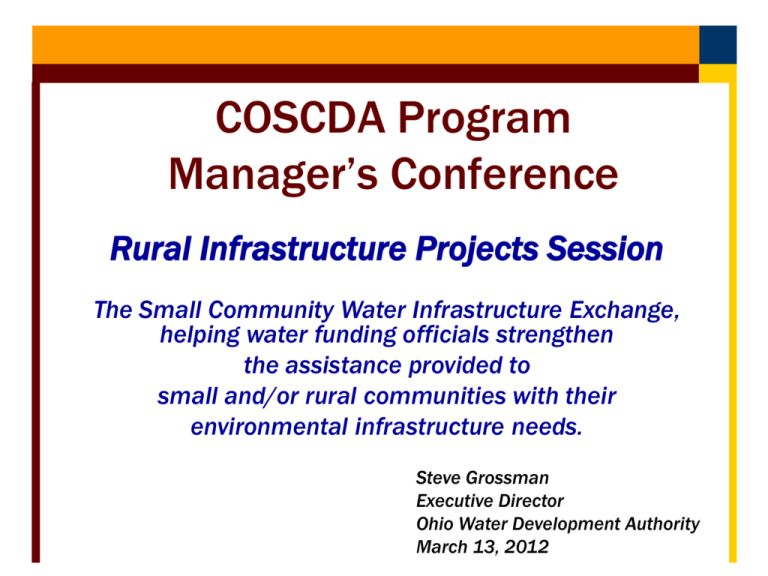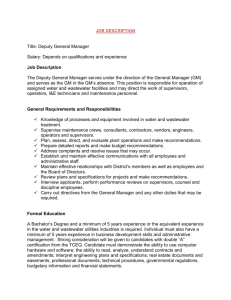Grossman - WA
advertisement

COSCDA Program Manager’s Conference Rural Infrastructure Projects Session The Small Community Water Infrastructure Exchange, helping water funding officials strengthen the assistance provided to small and/or rural communities with their environmental infrastructure needs. Steve Grossman Executive Director Ohio Water Development Authority March 13, 2012 Outline Small Community Water Infrastructure Exchange Ohio’s Small Community Environmental Infrastructure Group Nevada Water Wastewater Revision Committee Texas Water Infrastructure Coordinating Committee SCWIE Current Activities Statewide Support Groups With A Dedicated Website Arizona – Rural Water Infrastructure Committee Indiana – Environmental Infrastructure Working Group Montana – Water, Wastewater & Solid Waste Action Coordinating Team New York – NYS Water & Sewer Infrastructure Co-Funding Initiative North Carolina – UNC Environmental Finance Center Ohio – Small Communities Environmental Infrastructure Exchange Texas – Texas Water Infrastructure Coordination Committee Washington – Infrastructure Assistance Coordinating Council West Virginia – West Virginia Infrastructure & Jobs Development Council http://www.sceig.org/sceig0001.asp?pagename=home http://rwic.azwifa.gov/ http://www.ruralindiana.org/EIWG.php http://dnrc.mt.gov/cardd/ResourceDevelopment/wasact/Default.asp http://nycofunding.org/dotnetnuke/Default.aspx?tabid=68 http://www.efc.unc.edu/projects/infrastructurecoordination.htm http://www.twicc.org/ http://www.infrafunding.wa.gov/ http://www.wvinfrastructure.com/ Statewide Support Groups Without A Dedicated Website Alabama Minnesota Arkansas Missouri California Nebraska Colorado Nevada Delaware New Jersey Florida New Mexico Georgia North Dakota Idaho Oklahoma Illinois Oregon Iowa Pennsylvania Kansas South Carolina Kentucky South Dakota Maine Utah Maryland Vermont Massachusetts Wisconsin Michigan Wyoming States Without A Statewide Support Group Alaska Connecticut Hawaii Louisiana Mississippi New Hampshire Rhode Island Tennessee Virginia Helping Small Communities meet their Water & Wastewater System Needs What is S C E I G ? An association formed in 1990 Federal Agencies State Agencies Local/Regional Groups Educational Institutions Technical Assistance Providers Financial & Regulatory www.sceig.org Typical Communities Smaller communities With no system, older system Lower than average MHI figures Older, un-employed populations Lower Rates, Fewer Increases Slower than inflation Administrative Capacity Little/no grant experience www.sceig.org We usually work with Local officials Elected and Appointed Other Federal/State/Local Agencies Regulators and Funders Consulting Engineers Design and Technologies Technical Assistance Provider www.sceig.org How We Operate ? Coordination of Efforts 5 Committees: Finance Training Decentralized Wastewater Working Group Appalachia Environmental Infrastructure Strategy Work Group Small Systems Working Group www.sceig.org Coordination of Efforts Quarterly Steering Committee Meetings Goals Statement Yearly Objectives Legislative Briefing Outreach Efforts Finance Committee Meets Bi-Monthly with Community Leadership and Consulting Engineer www.sceig.org Project description (Download two page form at www.sceig.org) Status of Project Number of customers Total estimated costs User rates Source of Funding for Counties with Populations ODOD / Governor's Office of Under 80,000 Appalachia - Federal Funds ODOD / Governor's Office of 2000-2005 Appalachia - State Funds ODOD / Community Development Block Grant Ohio Public Works Commission Grant & Credit Enh OWDA Emergency Relief US Army Corp of Engineers USDA / Rural Development Grant USDC / Economic Development USEPA Federal Appropriations USHUD Community Development Block Grant - Fed Drinking Water Assistance Water Pollution Control Loan ODOD / Water & Sewer Rotary Loan Ohio Public Works Commission Loan OWDA Community Assistance Loan OWDA Local Economic Development Loan USDA / Rural Development Loan & Loan Guarantee OWDA Construction Loan Municipal Bonds Training Committee Workshops for community leaders facing decisions related to environmental infrastructure Water Wastewater RCAP Training, Toolkit Technical Fiscal Managerial Ohio RCAP Board Training Course 101 Utility Management for Local Officials Course 201 Financial Management for Local Officials Course 301 Asset Management, Budgeting, and Rate Setting for Local Officials CUPSS Training Check Up Program For Small Systems www.glrcap.org/ohio Decentralized Working Group Capacity Building, Consideration of Alternative Wastewater Solutions Promote de-centralized alternatives and management options Educate, disseminate information Facilitate, provide resources I Appalachian Environmental Infrastructure Strategy Work Group Effective delivery of technical and financial assistance from multiple sources Internet-based, information-sharing network Enables providers of public funds and technical assistance to easily communicate and share the status of a designated group of projects Small Systems Working Group Addressing the challenges to bring cost effective solutions for wastewater collection and treatment for the “very” small communities in the areas of: Community Leadership Appropriate Technology Funding Technical Assistance Ohio Rural Community Assistance Program Ohio State University Extension Ohio Environmental Protection Agency Ohio Rural University Program Infrastructure for Nevada Communities Formed in the late 1990s Discuss troubled systems and to find solutions Collaborate & Coordinate To promote efficient application of technical and financial assistance NWWRC Nevada Water Wastewater Review Committee Creation Development of joint funding application form stalled Focus on small rural communities Joint “pre-application” determined to be a viable alternative NWWRC NWWRC Purpose Intended to assist communities navigate multiple Agencies’ application processes Improve communication Avoid duplication Encourage cooperation NWWRC NWWRC Process Project Proposal Form (pre-application) for State Grants, DW/CW SRF, USDA, CDBG Committee meets within 3-4 weeks of receiving application NWWRC recommends most appropriate funding for applicant Applicant then completes individual Funding Agency’s application(s) NWWRC NWWRC Process – Correspondence NWWRC prepares comments pertinent to the technical, operational, or financial aspect of the project proposal Recommendation of most appropriate funding Substantive comments must be resolved prior to receiving a recommendation from the NWWRC NWWRC NWWRC Benefits Helps small communities identify funding opportunities & navigate the process Project Applicants know we are talking with each other – reduces “answer shopping” and the Agencies get consistent “stories” because they know we compare notes Agencies can help craft loan/grant packages Texas Background As of 2009, at least 17 years attempting to introduce and maintain a coordinated funding group Consistent Issues Not legislatively organized/required Ownership/responsibility Relationships not solid/mistrust Lack common goals and objectives Coordinating Group Formation Series of meetings held November 2009 through April 2010 at the request of EPA-Region 6 and facilitated by the New Mexico Environmental Finance Center Purpose “Discuss options for funding and other assistance to small water systems in the state of Texas that are not in compliance with the arsenic and uranium standards of the Safe Drinking Water Act” Evolution of Purpose and Outcome Based on state interest and needs Formed Texas Water Infrastructure Coordination Committee First formal meeting of TWICC on August 18, 2010 TWICC Defined Mission Statement “TWICC will collaborate to identify water and wastewater infrastructure and compliance issues and to seek affordable, sustainable and innovative funding strategies for the protection of public health and the efficient use of government resources in Texas” TWICC Defined Coordination group with four sub-committees Finance Targeting/Priorities Marketing/Outreach Uniform Standards First Year TWICC Activities Accomplishments Consistent attendance and interest Developed “Financial Program Comparison Tool” Established a project database Developed website (www.twicc.org) Gave presentation and hosted work session Developed “Project Profile Form” Buy in from EPA and public Met/corresponded with public Challenges Reorganization and reduction in force SFY 2012 TWICC Goals Foster better working relationships Prioritize outreach to systems impacted by compliance and drought issues Establish communication methods based on system needs Develop process steps to ensure consistency Determine frequency based on method utilized Uniform Standards Recommendations from EPA Region 6 and TCEQ Formalize procedures for Finance Sub-committee Internally- between TWICC member organizations Externally- with water and wastewater systems Establish guidance for Multi-Agency Environmental Review Review procurement requirements and Engineering Feasibility Report elements Marketing and Outreach Provide additional presentations Develop TWICC logo SCWIE 2012 Activities Standardize the format and reporting requirements of the Preliminary Engineering Report Ascertain the current level of activity of statewide support groups Continue to share experiences on the development and implementation of well-supported capacity development strategy to ensure that small systems acquire and maintain the technical, financial and managerial ability to provide safe drinking water







